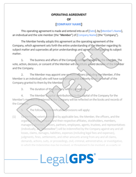IP Joint Venture Agreements: What Businesses Need to Know
In the ever-evolving world of business, strategic partnerships and collaborations have become common as companies leverage collective strengths to...
6 min read
LegalGPS : Jul. 25, 2024
When you’re building a business, protecting your intellectual property (IP) is one of the most important steps you can take. That’s where an Intellectual Property Assignment Agreement comes into play. This agreement ensures that any IP created—whether it’s a product design, software, or even a brand logo—belongs to your business, not the individual who created it. We'll cover everything you need to know in this guide!


Intellectual Property Assignment
Legal GPS templates are drafted by top startup attorneys and are fully customizable🛠️.
Trusted by 1000+ businesses to close secure deals.
An Intellectual Property Assignment Agreement is a legal document that ensures the transfer of an inventor or creator's rights to another person or company. Essentially, it’s a legal way of saying "what’s mine is now yours". These agreements are often used in situations involving startups, company buyouts, or employees creating new works or inventions during their jobs - situations a lot of entrepreneurs find themselves in.
Let's break that down a touch more:
The IP assignment agreement's primary purpose is to help your business prevent future disputes regarding IP ownership. When all parties are clear on who owns the intellectual property, it prevents a whole host of potential issues.
Believe me, the last thing you need or want as an entrepreneur is a legal dispute over who owns an idea, an invention, or any creative output.
And that's where this agreement steps in: it provides legal proof that the ownership has been transferred. So, if ever challenged, you can show the agreement and say "See, it’s mine!" .
When it comes to IP assignment agreements, not just any generic contract will do. It's crucial to understand and include some key elements to ensure you're fully protected.
The agreement must clearly define the scope and extent of the transferred rights. To do this, use precise language that leaves no room for confusion. For example, specify whether the IP rights being transferred are exclusive or non-exclusive and if there are any limitations on how the Assignee can use or sublicense the IP. Here's a suggested format:
"The Assignor hereby assigns to the Assignee, its successors and assigns, [exclusive/non-exclusive] rights, title, and interest in and to the Intellectual Property, subject to the following limitations [if any]:"
This section is where you identify the specific Intellectual Property being assigned. Start by describing the IP type (e.g., copyright, patent, trademark), then provide the necessary details:
For a copyright, include the work title and a brief description.
For a patent, mention the patent number and summarize the invention.
For a trademark, provide the trademark name, registration number, and design details.
Remember, the key is to be as detailed and transparent as possible.
Master Intellectual Property for Business Success
Just as with any deal, it's important to be crystal clear about the compensation for transferring IP rights. Make sure you consider the following in your agreement:
The total amount payable
The currency
The payment method (e.g., check, wire transfer)
The payment schedule (e.g., lump-sum, installments)
For example:
"In consideration for the assignment of rights, the Assignee shall pay the Assignor a total sum of [Amount] in [Currency], through [Payment Method], payable as follows:"
Including warranties and representations in the agreement helps provide confidence to both parties. The Assignor should explicitly declare that they:
Are the sole and true owner of the IP
Have the complete right to assign the IP to the Assignee
The IP does not infringe on any third-party rights
A sample clause might look like this:
"The Assignor warrants and represents that they are the true and lawful owner of the Intellectual Property, have full right and authority to enter into this Agreement, and that the Intellectual Property does not infringe upon any third-party rights."
A crucial aspect of a well-drafted IP Assignment Agreement is protecting sensitive information about the business and the IP itself. Incorporate confidentiality clauses to maintain a secure environment.
Try a clause similar to this one:
"The parties agree to treat all confidential information related to this Agreement as strictly confidential, and to take all necessary precautions to prevent unauthorized disclosure or use of such information."
Last but not least, outline which jurisdiction's laws will govern the agreement. Furthermore, state how any disputes will be resolved, such as through arbitration, mediation, or litigation.
A model clause could be:
"This Agreement shall be governed by the laws of the State of [State]. Any dispute arising out of or in connection with this Agreement shall be resolved by [method of dispute resolution]."


Legal GPS Pro
Protect your business with our complete legal subscription service, designed by top startup attorneys.
Let's move on to the most crucial part of our discussion: Creating your Intellectual Property Assignment Agreement. This section intends to make it much clearer and more action-oriented. Your aim? To walk away with enough information to begin drafting your agreement. Let's dive in.
Start by clearly naming the parties involved in the agreement.
Who is the 'Assignor' (the party transferring the rights)?
Who is the 'Assignee' (the individual or business entity receiving the rights)?
Clearly outline their legal names and any other relevant identifying information, like addresses or official business names. It would typically look like this: "[Full Legal Name], referred to as the "Assignor," and [Full Legal Name], referred to as the "Assignee."
Here, you need to provide a full and exhaustive description of the intellectual property being transferred. Please don't leave room for vagueness or ambiguity - the more specific, the better. For instance, if it's a patent, include the patent number and a detailed summary of what the patent covers. If it's a copyrighted work, offer the title, the form of the work (e.g., a book, software, music), and a short description of it.
Your entry here might read:
"The "Intellectual Property" includes, but is not limited to, [detailed description]."
Get Your Intellectual Property Assignment Agreement Template
with a Legal GPS Subscription
This section is all about clearly laying out what you're giving up and what you're gaining. Highlight all rights, titles, and interests being assigned from the Assignor to the Assignee. You could list them out just to ensure nothing falls between the cracks.
It’s vital to be as clear and detailed as possible here. You're specifying the extent of the rights transferred. It could be exclusive, non-exclusive, permanent, temporary, how it can be used, if it can be sold, and more.
Here's an example:
"The Assignor hereby assigns to the Assignee, its successors and assigns, all rights, title, and interest in and to the Intellectual Property, including, without limitation, the right to sue and recover for past, present, and future violations."
Now, let's talk about money. In this step, you need to fully detail the financial exchanges. Include the amount of payment, payment format, and schedule (upfront, lump sum, installments). It wouldn't hurt to clearly lay out what conditions, if any, would lead to a return of the compensation.
This clause might look something like:
"For the assignment of rights under this Agreement, the Assignee shall provide compensation to the Assignor in the amount of [Amount], payable [insert payment method and schedule]".
Especially with IP, you'll want to build in some safety nets. You can include a confidentiality clause that prevents the involved parties from disclosing sensitive information about the IP.
A basic confidentiality clause may read:
"The Assignor agrees to keep confidential all non-public information that the Assignee designates as being confidential, not to disclose it to any other people, and not to use it for any purpose other than the discharge of the Assignor's obligations under this Agreement."
Finally, specify which state or country's laws will govern the agreement. This is crucial in the case of any future legal disputes. Additionally, include how disputes over the agreement will be resolved - arbitration, mediation, litigation, etc.
Here is an example:
"This Agreement will be governed by and construed in accordance with the laws of the State of [State]. Any disputes under this Agreement shall be resolved by [method of dispute resolution]."

Intellectual Property Assignment
Legal GPS templates are drafted by top startup attorneys and are fully customizable🛠️.
Trusted by 1000+ businesses to close secure deals.
You're now equipped with all you need to draft an agreement. But before you get started, here are some quick tips to avoid any missteps:
Ensure the agreement is detailed and described correctly
Work with a knowledgeable attorney
Review the final agreement carefully before signing
With these, you're set to protect your business's most valuable assets!
In today's competitive business environment, it's imperative to protect your inventions, your creations - your Intellectual Property. If you're still unsure where to start, check out our professional template for Intellectual Property Assignments!
With an Intellectual Property Assignment Agreement in hand, you're ensuring that ownership of these is well established to prevent future disputes.
Get Legal GPS's Intellectual Property Assignment Agreement Template Now
The biggest question now is, "Do I need a business lawyer?” For most businesses and in most cases, you don't need a lawyer to start your business. Instead, many business owners rely on Legal GPS Pro to help with legal issues.
Legal GPS Pro is your All-In-One Legal Toolkit for Businesses. Developed by top startup attorneys, Pro gives you access to 100+ expertly crafted templates including operating agreements, NDAs, and service agreements, and an interactive platform. All designed to protect your company and set it up for lasting success.

Legal GPS Pro
Protect your business with our complete legal subscription service, designed by top startup attorneys.
| Premium Template Single-use Template |
Legal GPS Pro Unlimited Access, Best Value |
|
|
| Get Template | Learn More |
| Trusted by 1000+ businesses | |

In the ever-evolving world of business, strategic partnerships and collaborations have become common as companies leverage collective strengths to...

As an entrepreneur, one of your most valuable assets is your company's intellectual property (IP). From trade secrets and customer lists to patented...

When it comes to navigating the ever-changing landscape of legal matters and protecting your business, understanding the intricacies of specific...